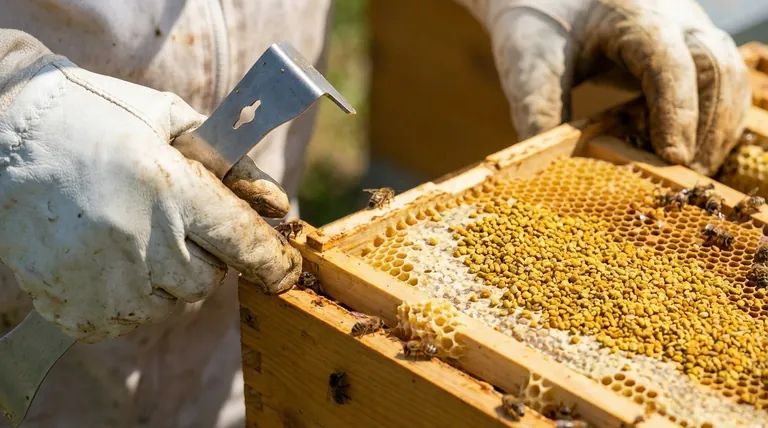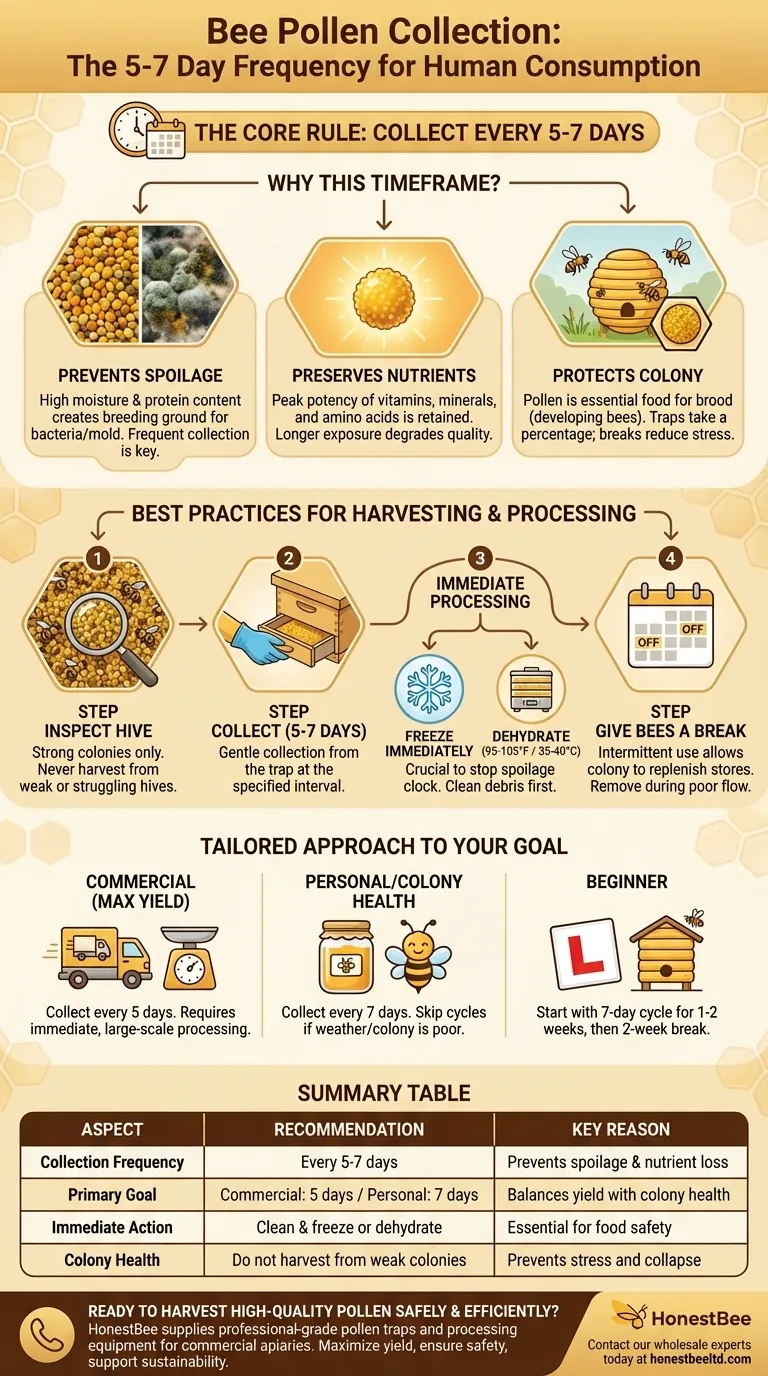For human consumption, bee pollen should be collected from the hive every 5 to 7 days. This specific timeframe is critical for ensuring the pollen is safe, fresh, and nutritionally potent, while also safeguarding the health of the bee colony that produces it.
The core challenge of pollen harvesting is not just collection, but preservation. Because fresh pollen is a high-moisture product, frequent collection combined with immediate processing is the only way to prevent spoilage and ensure its safety for human use.

The Principles Behind the 5-7 Day Window
Harvesting pollen is a delicate balance. You are intercepting the bees' primary source of protein before it enters the hive. The 5-7 day rule is a guideline rooted in food safety and sustainable beekeeping practices.
Why Frequent Collection Prevents Spoilage
Pollen collected by bees is mixed with nectar, making it moist and rich in protein. This makes it an ideal breeding ground for bacteria, yeast, and mold.
Leaving a pollen trap on for longer than a week, especially in humid conditions, dramatically increases the risk of contamination. The collected pollen can begin to ferment or grow mold, rendering it unsafe for consumption.
Preserving Maximum Nutritional Value
Bee pollen is valued for its rich profile of vitamins, minerals, and amino acids. These components are most potent when the pollen is fresh.
The longer pollen sits in a trap, exposed to air, humidity, and temperature fluctuations, the more its nutritional quality degrades. A 5-7 day cycle ensures you are harvesting a product at its peak potency.
The Impact on the Bee Colony
Pollen is the essential food for developing bees, known as brood. It provides the protein necessary for their growth. A pollen trap works by gently scraping a percentage of pollen from the legs of returning forager bees.
It does not collect all the pollen, allowing the colony to continue feeding itself. However, continuous collection without breaks can still stress a colony, especially during critical periods of growth or when nectar and pollen sources are scarce.
Understanding the Trade-offs and Best Practices
Simply following the 5-7 day rule is not enough. Successful and ethical harvesting requires active management and observation of both the product and the bees.
Never Harvest from a Weak Colony
A strong, thriving colony with a large population can easily sustain partial pollen collection. A weak or struggling colony cannot.
Before installing a pollen trap, always inspect the hive. If you see signs of a small population, disease, or a lack of stored pollen and honey, do not attempt to harvest pollen. Doing so could lead to the colony's collapse.
Immediate Processing is Non-Negotiable
The moment you collect pollen from the trap, the clock is ticking. You must process it immediately to preserve it.
First, clean the pollen of any debris, such as bee wings or legs. Then, you must either freeze it immediately or begin dehydrating it at a low temperature (around 95-105°F or 35-40°C) until it is completely dry. Storing raw, unprocessed pollen at room temperature will lead to spoilage within hours or days.
Know When to Give the Bees a Break
Do not keep the pollen trap active on the hive indefinitely. A good practice is to collect pollen for a few weeks and then deactivate the trap for a week or two.
This allows the colony to fully replenish its own stores and reduces the overall stress on the bees. Always remove traps during a poor nectar flow or periods of bad weather when bees cannot forage effectively.
Making the Right Choice for Your Goal
Your specific approach to the 5-7 day rule can be adjusted based on your primary objective.
- If your primary focus is maximum yield for commercial use: Collect every 5 days to ensure the highest quality and lowest risk of spoilage, but be prepared for immediate, large-scale cleaning and drying or freezing.
- If your primary focus is personal use and colony health: Collect every 7 days and consider skipping a collection cycle if the weather has been poor or if you observe any reduction in colony strength.
- If you are a beginner: Start with a 7-day schedule, collect for only one or two weeks, and then give the colony a two-week break to ensure you do not inadvertently harm them.
Responsible pollen harvesting is an act of partnership with your bees, ensuring their health while producing a safe and valuable product.
Summary Table:
| Aspect | Recommendation | Key Reason |
|---|---|---|
| Collection Frequency | Every 5-7 days | Prevents spoilage & nutrient loss |
| Primary Goal | Commercial use: 5 days Personal use: 7 days |
Balances yield with colony health |
| Immediate Action | Clean & freeze or dehydrate | Essential for food safety |
| Colony Health | Do not harvest from weak colonies | Prevents stress and collapse |
Ready to harvest high-quality pollen safely and efficiently?
As a commercial beekeeper or distributor, you need reliable, high-volume equipment to support your 5-7 day harvesting cycle. HONESTBEE supplies professional-grade pollen traps and processing equipment designed for the demands of commercial apiaries.
We help you:
- Maximize yield with durable, efficient pollen traps.
- Ensure product safety with equipment suited for rapid processing.
- Support sustainable beekeeping practices with well-designed tools.
Contact our wholesale experts today to discuss the right equipment for your operation and ensure your pollen harvest is both productive and safe.
Visual Guide

Related Products
- HONESTBEE Advanced Ergonomic Stainless Steel Hive Tool for Beekeeping
- Professional Dual-End Stainless Steel Hive Tool for Beekeeping
- Full Set Beekeeping Electronic Bee Venom Collector Machine Device for Bee Venom Collecting
- Professional Galvanized Hive Strap with Secure Locking Buckle for Beekeeping
- Beehive Handle and Frame Rest Cutting Machine: Your Specialized Hive Machine
People Also Ask
- What is the hole in a hive tool for? A Multi-Tool for Apiary Repairs and Maintenance
- What are the features of a regular hive tool? The Essential Multi-Tool for Every Beekeeper
- What are some common uses of a hive tool? Essential Multi-Purpose Tool for Every Beekeeper
- What is a hive tool and what are its uses? Master Your Hive Inspections with the Essential Beekeeper's Tool
- What tools are used for cleaning frames? A Beekeeper's Simple 4-Tool Guide



















